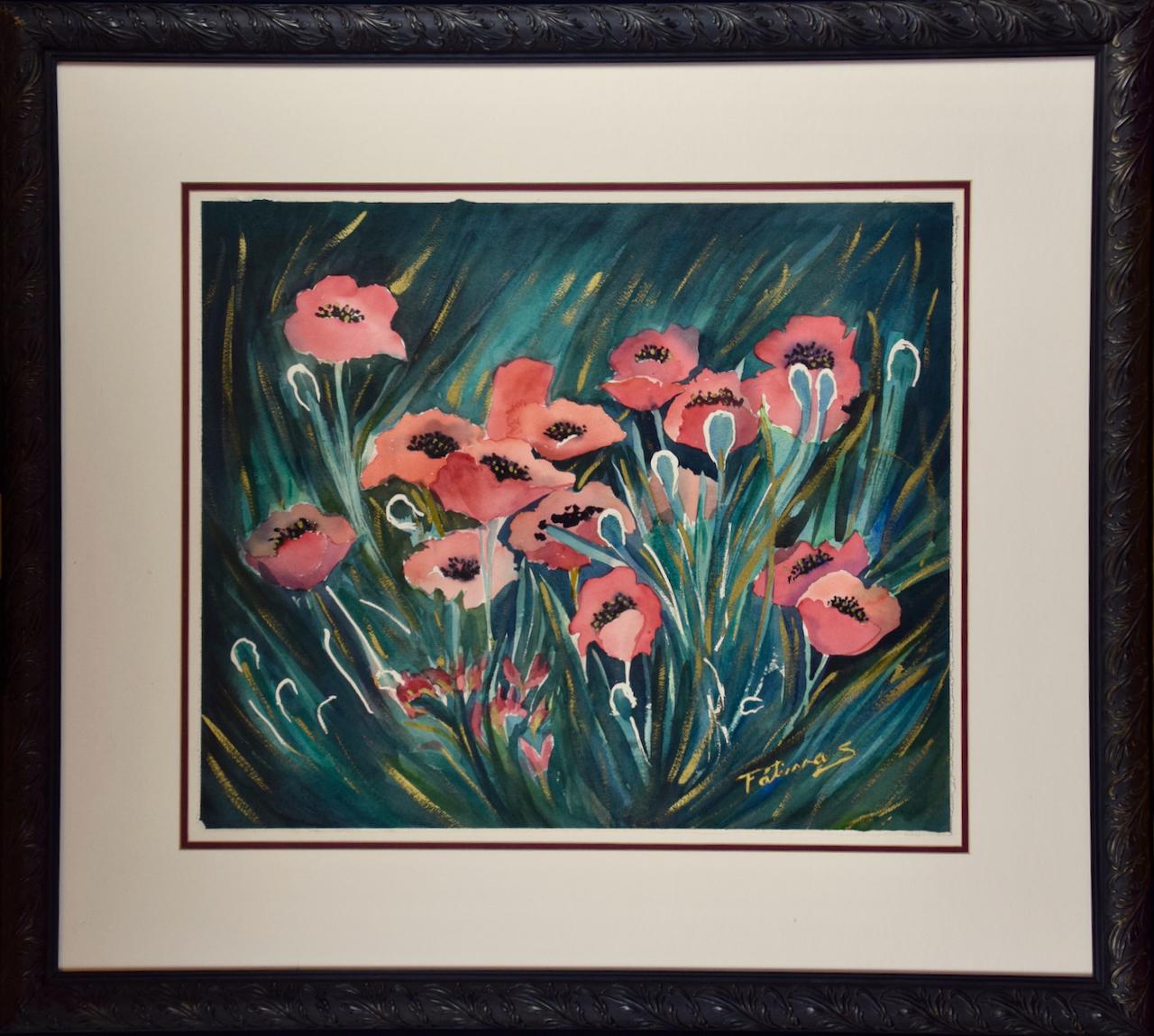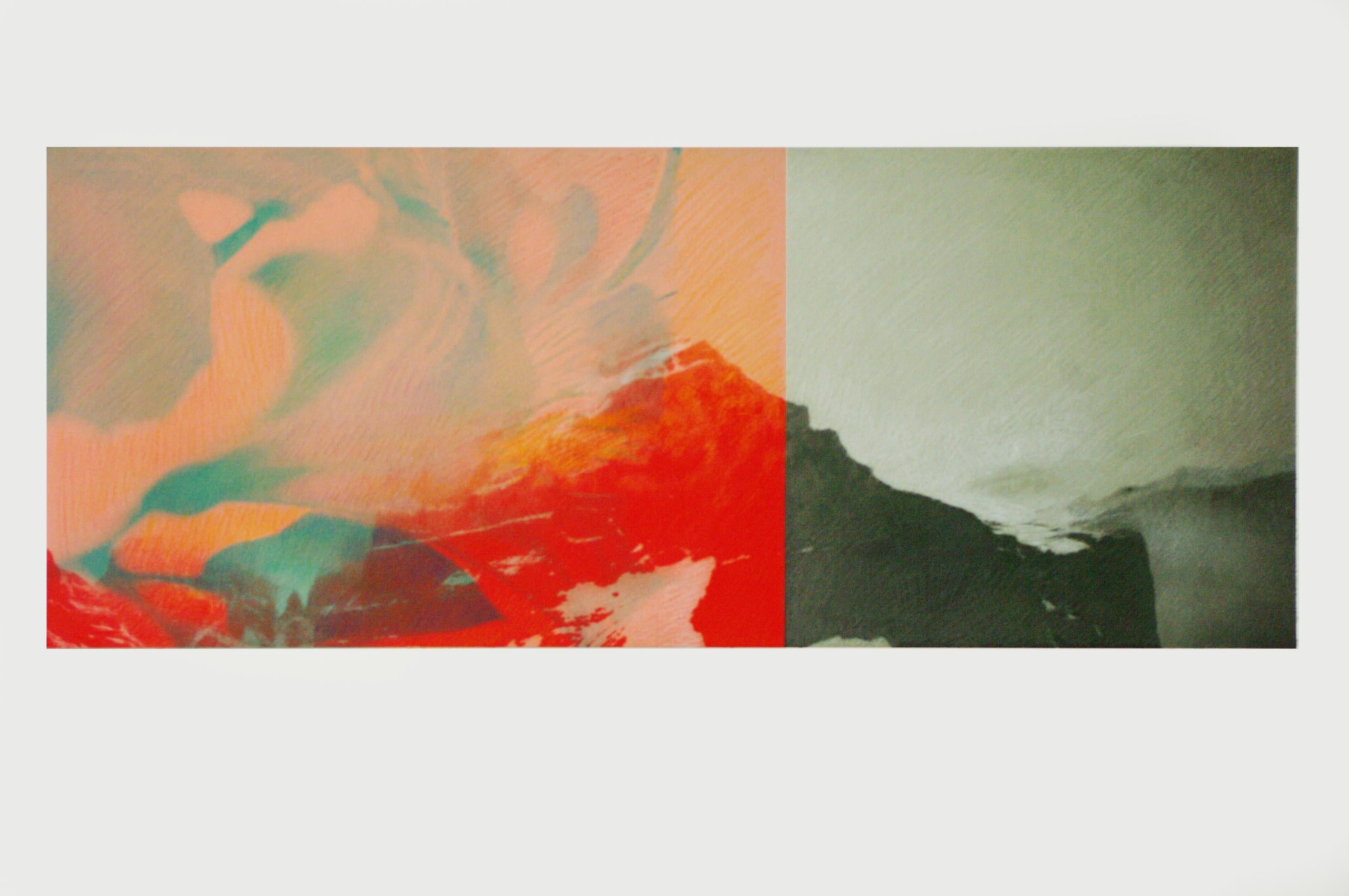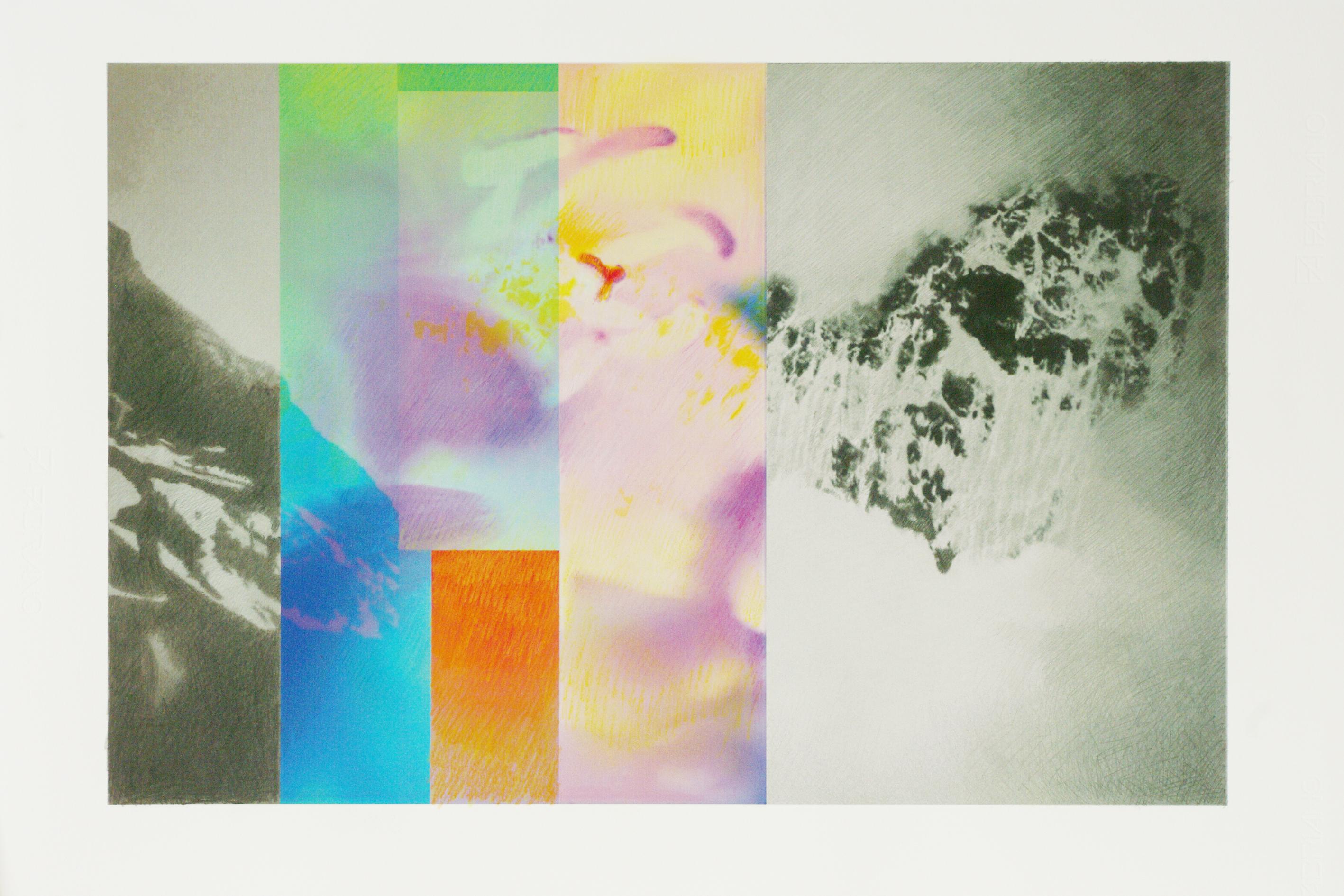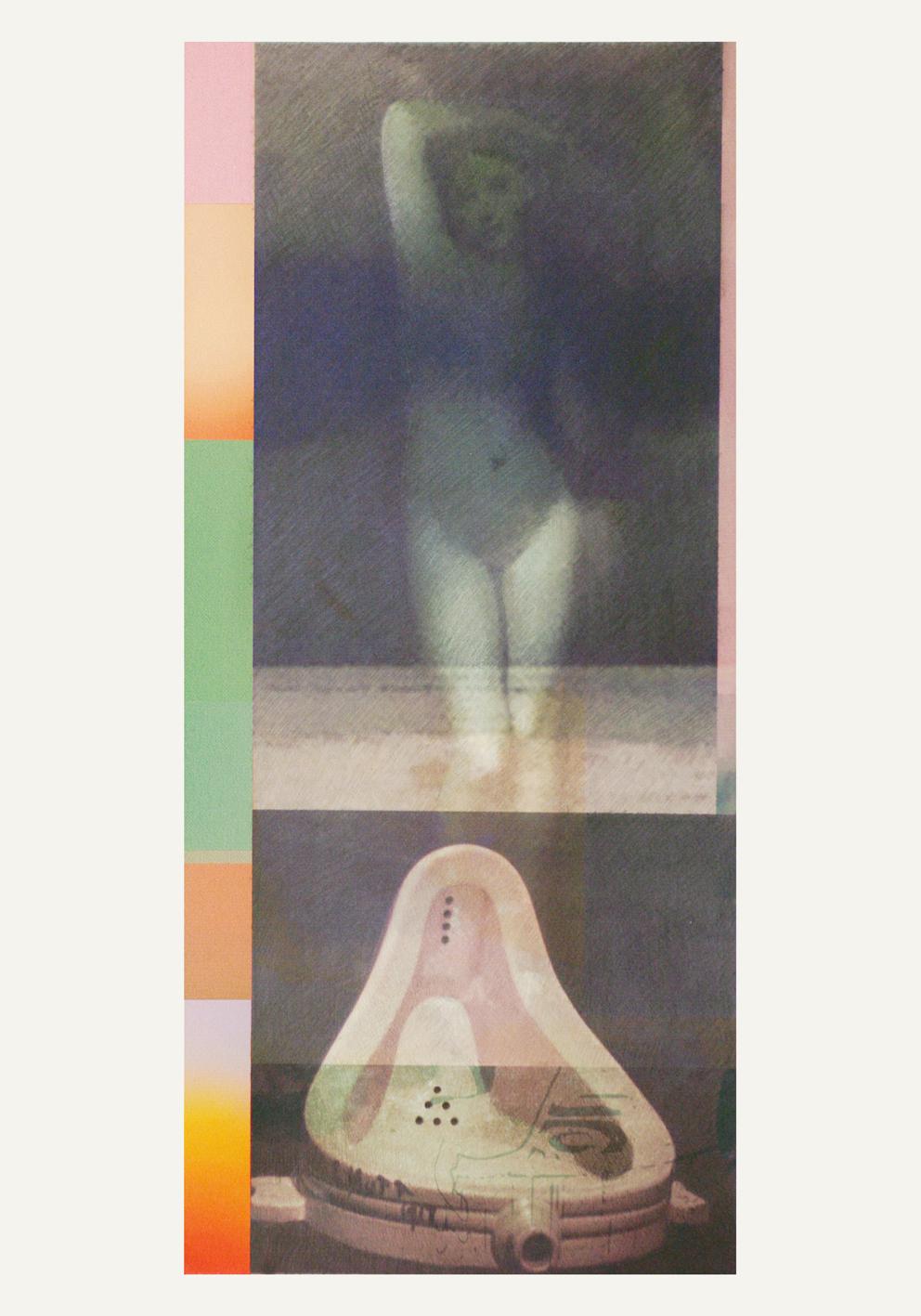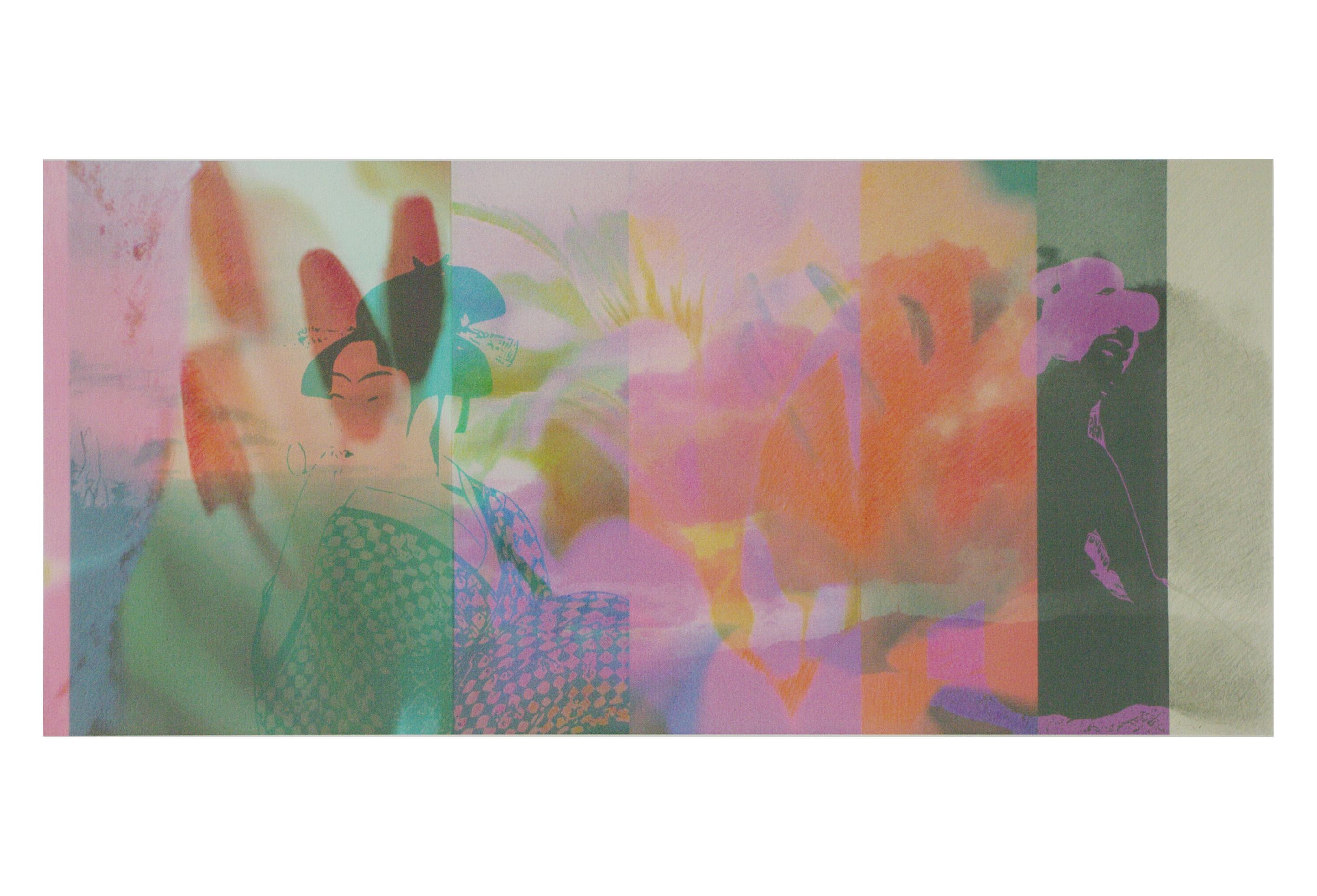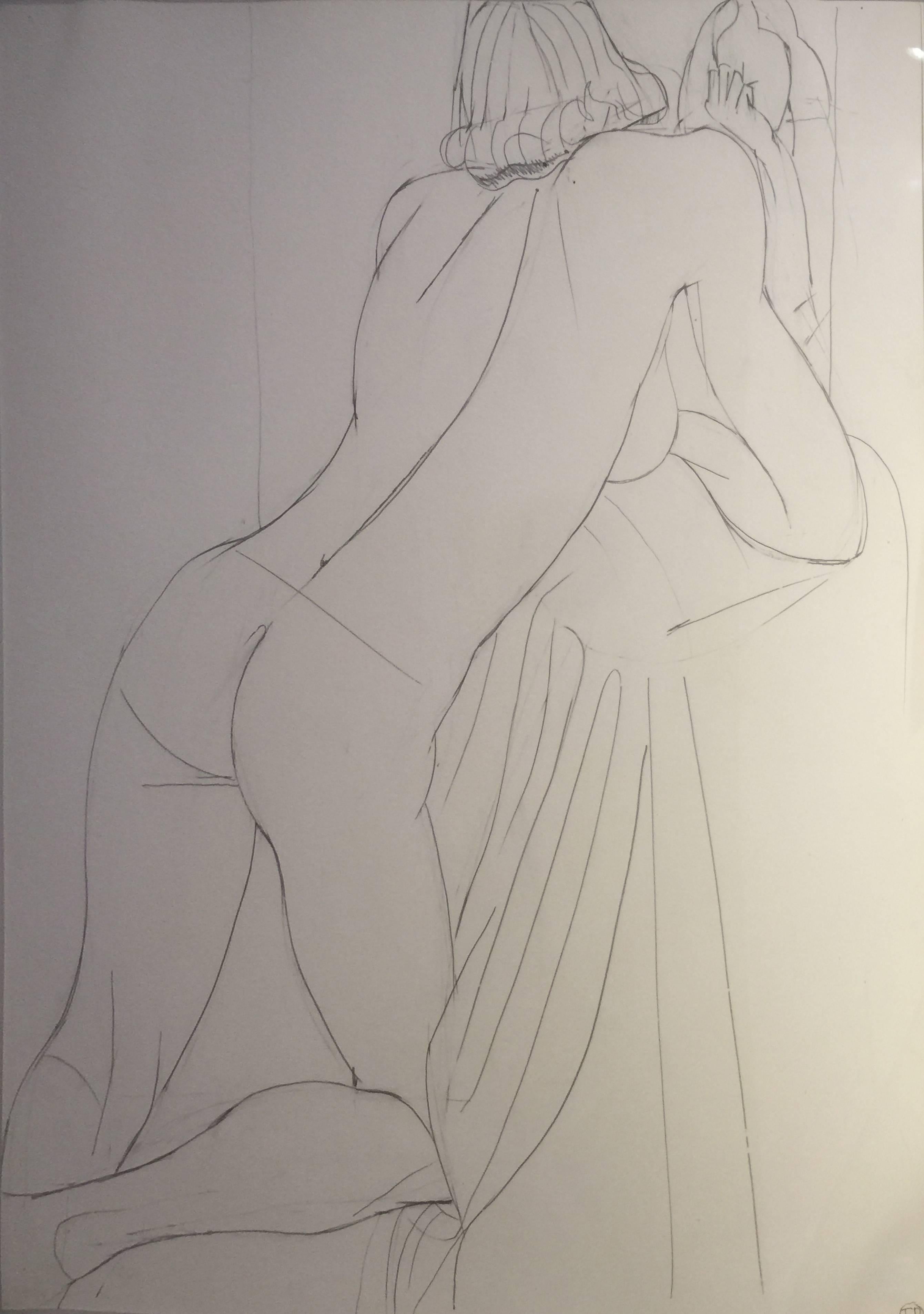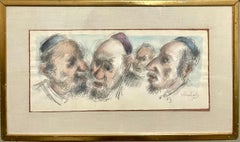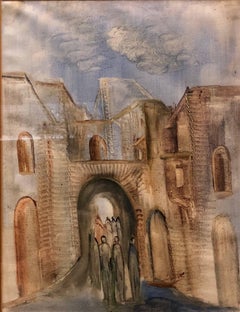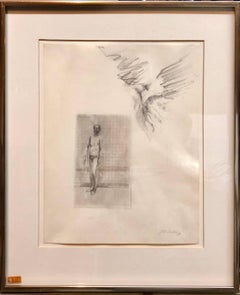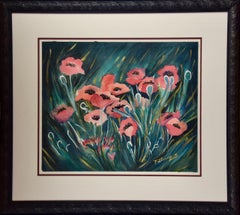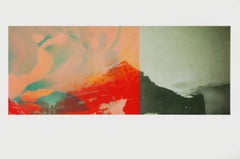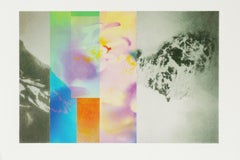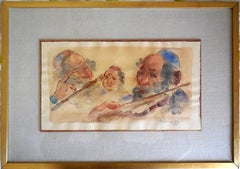
Jewish Klezmer Musicians, Judaica watercolor
View Similar Items
Want more images or videos?
Request additional images or videos from the seller
1 of 8
Chaim GrossJewish Klezmer Musicians, Judaica watercolor
About the Item
- Creator:Chaim Gross (1904-1991, American)
- Dimensions:Height: 15 in (38.1 cm)Width: 21.25 in (53.98 cm)
- Condition:frame has minor age wear, but is perfectly servicable.
- Gallery Location:Surfside, FL
- Reference Number:1stDibs: LU382126346
About the Seller
4.9
Platinum Seller
These expertly vetted sellers are 1stDibs' most experienced sellers and are rated highest by our customers.
Established in 1995
1stDibs seller since 2014
Typical response time: 1 hour
More From This SellerView All
- Chaim Gross Mid Century Mod Judaica Jewish Watercolor Painting Rabbis WPA ArtistBy Chaim GrossLocated in Surfside, FLChaim Gross (American, 1904-1991) Watercolor painting Rabbinical Talmudic Discussion Hand signed 17 x 29 framed, paper 10 x 22 Chaim Gross (March 17, 1904 – May 5, 1991) was an American modernist sculptor and educator. Gross was born to a Jewish family in Austrian Galicia, in the village of Wolowa (now known as Mezhgorye, Ukraine), in the Carpathian Mountains. In 1911, his family moved to Kolomyia (which was annexed into the Ukrainian USSR in 1939 and became part of newly independent Ukraine in 1991). When World War I ended, Gross and brother Avrom-Leib went to Budapest to join their older siblings Sarah and Pinkas. Gross applied to and was accepted by the art academy in Budapest and studied under the painter Béla Uitz, though within a year a new regime under Miklos Horthy took over and attempted to expel all Jews and foreigners from the country. After being deported from Hungary, Gross began art studies at the Kunstgewerbeschule in Vienna, Austria shortly before immigrating to the United States in 1921. Gross's studies continued in the United States at the Beaux-Arts Institute of Design, where he studied with Elie Nadelman and others, and at the Art Students League of New York, with Robert Laurent. He also attended the Educational Alliance Art School, studying under Abbo Ostrowsky, at the same time as Moses Soyer and Peter Blume. In 1926 Gross began teaching at The Educational Alliance, and continued teaching there for the next 50 years. Louise Nevelson was among his students at the Alliance (in 1934), during the time she was transitioning from painting to sculpture. In the late 1920s and early 1930s he exhibited at the Salons of America exhibitions at the Anderson Galleries and, beginning in 1928, at the Whitney Studio Club. In 1929, Gross experimented with printmaking, and created an important group of 15 linocuts and lithographs of landscapes, New York City streets and parks, women in interiors, the circus, and vaudeville. The entire suite is now in the collection of the Philadelphia Museum of Art. Gross returned to the medium of printmaking in the 1960s, and produced approximately 200 works in the medium over the next two decades. For more than sixty years Chaim Gross's art has expressed optimistic, affirming themes, Judaica, balancing acrobats, cyclists, trapeze artists and mothers and children convey joyfulness, modernism, exuberance, love, and intimacy. This aspect of his work remained consistent with his Jewish Hasidic heritage, which teaches that only in his childlike happiness is man nearest to God. In March 1932 Gross had his first solo exhibition at Gallery 144 in New York City. For a short time they represented Gross, as well as his friends Milton Avery, Moses Soyer, Ahron Ben-Shmuel and others. Gross was primarily a practitioner of the direct carving method, with the majority of his work being carved from wood. Other direct carvers in early 20th-century American art include William Zorach, Jose de Creeft, and Robert Laurent. Works by Chaim Gross can be found in major museums and private collections throughout the United States, with substantial holdings (27 sculptures) at the Hirshhorn Museum and Sculpture Garden. A key work from this era, now at the Smithsonian American Art Museum, is the 1932 birds-eye maple Acrobatic Performers, which is also only one and one quarter inch thick. In 1933 Gross joined the government's PWAP (Public Works of Art Project), which transitioned into the WPA (Works Progress Administration), which Gross worked for later in the 1930s. Under these programs Gross taught and demonstrated art, made sculptures that were placed in schools and public colleges, made work for Federal buildings including the Federal Trade Commission Building, and for the France Overseas and Finnish Buildings at the 1939 New York World's Fair. Gross was also recognized during these years with a silver medal at the Exposition universelle de 1937 in Paris, and in 1942, with a purchase prize at the Metropolitan Museum of Art's "Artists for Victory" exhibition for his wood sculpture of famed circus performer Lillian Leitzel. In 1949 Gross sketched Chaim Weizmann, Israeli President, at several functions in New York City where Weizmann was speaking, Gross completed the bust in bronze later that year. Gross returned to Israel for three months in 1951 (the second of many trips there in the postwar years) to paint a series of 40 watercolors of life in various cities. This series was exhibited at the Jewish Museum (Manhattan) in 1953. He also did some important Hebrew medals. In the 1950s Gross began to make more bronze sculptures alongside his wood and stone pieces, and in 1957 and 1959 he traveled to Rome to work with famed bronze foundries including the Nicci foundry. At the end of the decade Gross was working primarily in bronze which allowed him to create open forms, large-scale works and of course, multiple casts. Gross's large-scale bronze The Family, donated to New York City in 1991 in honor of Mayor Ed Koch, and installed at the Bleecker Street Park at 11th street, is now a fixture of Greenwich Village. In 1959, a survey of Gross's sculpture in wood, stone, and bronze was featured in the exhibit Four American Expressionists curated by Lloyd Goodrich at the Whitney Museum of American Art, with work by Abraham Rattner, Doris Caesar, and Karl Knaths. In 1976, a selection from Gross's important collection of historic African sculpture, formed since the late 1930s, was exhibited at the Worcester Art Museum in the show The Sculptor's Eye: The African Art Collection of Mr. and Mrs. Chaim Gross. Gross was elected into the National Academy of Design as an Associate member, and became a full Academician in 1981. In 1984, he was inducted into the American Academy of Arts and Letters, with Jacob Lawrence and Lukas Foss. In the fall of 1991, Allen Ginsberg gave an important tribute to Gross at the American Academy of Arts and Letters, which is published in their Proceedings. In 1994, Forum Gallery, which now represents the Chaim Gross estate, held a memorial exhibition featuring a sixty-year survey of Gross's work.In March 1932 Gross had his first solo exhibition at Gallery 144 in New York City. For a short time they represented Gross, as well as his friends Milton Avery, Moses Soyer, Ahron Ben-Shmuel and others. Gross was primarily a practitioner of the direct carving method, with the majority of his work being carved from wood. Other direct carvers in early 20th-century American art include William Zorach, Jose de Creeft, and Robert Laurent. Works by Chaim Gross can be found in major museums and private collections throughout the United States, with substantial holdings (27 sculptures) at the Hirshhorn Museum and Sculpture Garden. A key work from this era, now at the Smithsonian American Art Museum, is the 1932 birds-eye maple Acrobatic Performers, which is also only one and one quarter inch thick. In 1933 Gross joined the government's PWAP (Public Works of Art Project), which transitioned into the WPA (Works Progress Administration), which Gross worked for later in the 1930s. Under these programs Gross taught and demonstrated art, made sculptures that were placed in schools and public colleges, made work for Federal buildings including the Federal Trade Commission Building, and for the France Overseas and Finnish Buildings at the 1939 New York World's Fair. Gross was also recognized during these years with a silver medal at the Exposition universelle de 1937 in Paris, and in 1942, with a purchase prize at the Metropolitan Museum of Art's "Artists for Victory" exhibition for his wood sculpture of famed circus performer Lillian Leitzel. In 1949 Gross sketched Chaim Weizmann, President of Israel, at several functions in New York City where Weizmann was speaking, Gross completed the bust in bronze later that year. Gross returned to Israel for three months in 1951 (the second of many trips there in the postwar years) to paint a series of 40 watercolors of life in various cities. This series was exhibited at the Jewish Museum (Manhattan) in 1953. In the 1950s Gross began to make more bronze sculptures alongside his wood and stone pieces, and in 1957 and 1959 he traveled to Rome to work with famed bronze foundries including the Nicci foundry. At the end of the decade Gross was working primarily in bronze which allowed him to create open forms, large-scale works and of course, multiple casts. Gross's large-scale bronze The Family, donated to New York City in 1991 in honor of Mayor Ed Koch, and installed at the Bleecker Street Park at 11th street, is now a fixture of Greenwich Village. In 1959, a survey of Gross's sculpture in wood, stone, and bronze was featured in the exhibit Four American Expressionists curated by Lloyd Goodrich at the Whitney Museum of American Art, with work by Abraham Rattner, Doris Caesar, and Karl Knaths. In 1976, a selection from Gross's important collection of historic African sculpture, formed since the late 1930s, was exhibited at the Worcester Art Museum in the show The Sculptor's Eye: The African Art Collection of Mr. and Mrs. Chaim Gross. Gross was elected into the National Academy of Design as an Associate member, and became a full Academician in 1981. In 1984, he was inducted into the American Academy of Arts and Letters, with Jacob Lawrence and Lukas Foss. In the fall of 1991, Allen Ginsberg gave an important tribute to Gross at the American Academy of Arts and Letters, which is published in their Proceedings. In 1994, Forum Gallery, which now represents the Chaim Gross estate, held a memorial exhibition featuring a sixty-year survey of Gross's work. Gross was a professor of printmaking and sculpture at both the Educational Alliance and the New School for Social Research in New York City, as well as at the Brooklyn Museum Art School, the MoMA art school, the Art Student's League and the New Art School (which Gross ran briefly with Alexander Dobkin...Category
Mid-20th Century American Modern Figurative Drawings and Watercolors
MaterialsPaper, Watercolor
- Jerusalem Old City Landscape, Expressionist Judaica Israeli Painting IIBy Andre ElbazLocated in Surfside, FLIn this painting the artist uses gestural brushstrokes, which causes distortion and exaggeration for emotional effect. Andre Elbaz uses as his subject figures walking in old city Jerusalem. André Elbaz (born April 26, 1934, El Jadida, Morocco) is a famous Moroccan painter and filmmaker. Elbaz studied art and theatre in Rabat and Paris from 1950 to 1961. He started painting only at the age of 21, until which age he had been interested mainly in theatre. A few years later, he managed to combine his two passions into a new approach in art-therapy, inventing together with his wife, a psychiatrist, the Pictodrame, which brought him world recognition. His first exhibition, which was very successful, took place in Casablanca in 1961 and earned him an appointment as Professor at the Beaux-Arts school in Casablanca. Years later, in 1976, he exhibited his paintings at the Tel-Aviv Museum. In parallel to his career as a painter, Elbaz is also known as a filmmaker. He produced several short films in France, Canada and the United States. One of them, La nuit n'est jamais complète (The night is never complete), won a prize at the "5th Biennale de Paris in 1967". Among the themes chosen for the many films he produced, there was a short one about the Warsaw Ghetto uprising, as well as a series of drawings entitled Seuls (Alone), with texts written by both Elie Wiesel...Category
20th Century Expressionist Figurative Paintings
MaterialsGouache, Paper
- Abstract Modernist Drawing of a Nude Man with Winged Figure, AngelBy John DobbsLocated in Surfside, FLAbstracted portrait of a nude man and an angel or winged figure by artist John Dobbs. This impressionistic depiction of the subject allows for stylistic references to Monet, and Sisley. John Barnes Dobbs...Category
20th Century Contemporary Figurative Drawings and Watercolors
MaterialsWatercolor
- Man and Dionysus Heimrad Prem German Expressionist Watercolor Painting Art BrutBy Heimrad PremLocated in Surfside, FLGenre: Expressionist Subject: Figures Medium: Watercolor Surface: Paper Country: Austria Dimensions w/Frame: 21" x 26 3/4" Heimrad Prem (1934 – 1978) was a German painter born in Roding, Oberpfalz. From 1949–1952 he studied decorative painting at Schwandorf and then studied painting with Josef Oberberger and sculpture with Toni Stadler at the Akademie der Bildenden Künste, Munich until 1956. While studying painting with Ernst Emil Schumacher at the Hochschule der Künste, Berlin, he formed Gruppe SPUR with Lothar Fischer, Helmut Sturm, and Hans-Peter Zimmer. After meeting Asger Jorn, SPUR joined the Situationist International. He was influenced by the Cobra artists Karel Appel and Otmar Alt. In 1960 he won a scholarship of the Kulturpreises im Bundesverband der Deutschen Industrie, Cologne. From 1960–1962 he co-edited the magazine SPUR. In 1961 he visited Oerkelljunga, Sweden with Sturm, Zimmer and Dieter Kunzelmann staying with Jørgen Nash...Category
1970s Expressionist Figurative Drawings and Watercolors
MaterialsWatercolor
- Modernist Watercolor Painting Peter Goldman American Filmmaker Neo ExpressionistBy Peter Emanuel GoldmanLocated in Surfside, FLPoetry piece. Based on poem or song. Paris, France Watercolor painting hand signed by Peter Emanuel Goldman. Legendary French American Film Auteur, These are recently produced water...Category
21st Century and Contemporary Neo-Expressionist Abstract Drawings and Wa...
MaterialsPaper, Watercolor
- Plunder at the Jewish Ghetto, Chalk and Charcoal 'Progrom' DrawingBy Victor E. PenneyLocated in Surfside, FLChalk and charcoal drawing, depicting old world progrom, "Plunder at the Jewish Ghetto, Jews of Frankfurt are attacked in the 16th century."Category
20th Century Modern Figurative Drawings and Watercolors
MaterialsPaper, Chalk, Charcoal
You May Also Like
- Watercolor of Flowers in a Field: Large Framed Colorful Botanical by Fatima S.Located in Alamo, CAThis beautiful framed botanical watercolor painting is signed Fatima S in the lower right. This colorful botanical painting depicts peach-c...Category
Late 20th Century Still-life Drawings and Watercolors
MaterialsWatercolor
- F124 - Contemporary, Abstract, Expressionist, Modern, Pop art, Surrealist,By Francisco NicolásLocated in London, LondonFlowers at the mountains III, 2015 (Unframed) His work has been shown in Reina Sofía Museum of Madrid, Royal Academy of London, Arco Madrid, Pinta Art Fair, London, London Art Fair...Category
2010s Contemporary Mixed Media
MaterialsPencil, Paper, Ink
- F124 - Contemporary, Abstract, Expressionist, Modern, Pop art, Surrealist,By Francisco NicolásLocated in London, LondonFlowers at the mountains II, 2015 (Unframed) His work has been shown in Reina Sofía Museum of Madrid, Royal Academy of London, Arco Madrid, Pinta Art Fair, London, London Art Fair,...Category
2010s Contemporary Mixed Media
MaterialsPaper, Ink, Pencil
- F122 - Contemporary, Abstract, Expressionist, Modern, Pop art, Surrealist,By Francisco NicolásLocated in London, LondonOne fountain at the mountain IV, 2019 (Unframed) His work has been shown in Reina Sofía Museum of Madrid, Royal Academy of London, Arco Madrid, Pinta Art Fair, London, London Art F...Category
2010s Contemporary Mixed Media
MaterialsPaper, Ink, Pencil
- F122 - Contemporary, Abstract, Expressionist, Modern, Pop art, Surrealist,By Francisco NicolásLocated in London, LondonOne fountain at the mountain IV, 2019 (Unframed) His work has been shown in Reina Sofía Museum of Madrid, Royal Academy of London, Arco Madrid, Pinta Art Fair, London, London Art F...Category
2010s Contemporary Mixed Media
MaterialsPaper, Ink, Pencil
- F124 - Contemporary, Abstract, Expressionist, Modern, Pop art, Surrealist,By Francisco NicolásLocated in London, LondonFlowers at the mountains III, 2015 (Unframed) His work has been shown in Reina Sofía Museum of Madrid, Royal Academy of London, Arco Madrid, Pinta Art Fair, London, London Art Fair...Category
2010s Contemporary Mixed Media
MaterialsPaper, Ink, Pencil
Recently Viewed
View AllMore Ways To Browse
Sleeping Boy
Judaica Medal
Gold Chaims
Firing Cannons
Cannon Fire
Sabbath Art Paintings
Chaim Gross Framed
Klezmer Musicians
Painting Xix
Retro Fashion Sketches
Antique Chinese Watercolor Painting
Small Charcoal Drawing
Chinese Black Ink Painting
Watercolors Of Doors
Watercolor And Ink Children
Charcoal Drawing Man
Graphite Sketch
Charcoal Drawings Sketch
